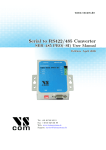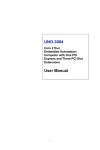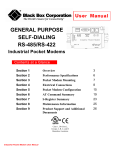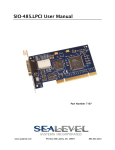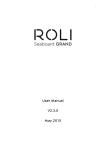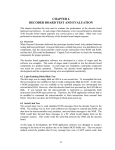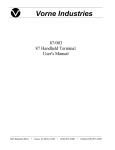Download Serial to RS422/485 Converter Serial to RS422/485 Converter
Transcript
www.vscom.de Serial Serial to to RS422/485 RS422/485 Converter Converter SER–485 SER–485 Lite Lite User User Manual Manual Edition: Edition: April April 2008 2008 Tel: +49 40 528 401 0 Fax: +49 40 528 401 99 Web: www.visionsystems.de Support: [email protected] The software described in this manual is furnished under a license agreement and may be used only in accordance with the terms of that agreement. Copyright Notice c 2007 Vision Systems. All rights reserved. Reproduction without permission is proCopyright hibited. Trademarks VScom is a trademark of Vision Systems GmbH. All other trademarks and brands are property of their rightful owners. Disclaimer Vision Systems reserves the right to make changes and improvements to its product without providing notice. Vision Systems provides this document “as is,” without warranty of any kind, either expressed or implied, including, but not limited to, its particular purpose. Vision Systems reserves the right to make improvements and/or changes to this manual, or to the products and/or the programs described in this manual, at any time. Information provided in this manual is intended to be accurate and reliable. However, Vision Systems assumes no responsibility for its use, or for any infringements on the rights of third parties that may result from its use. This product might include unintentional technical or typographical errors. Changes are periodically made to the information herein to correct such errors, and these changes are incorporated into new editions of the publication. April 2008 SER–485 Lite User Manual 2 Contents Contents 1 Overview 5 2 Introduction 5 3 Operation Modes 6 4 Technical Data 7 5 Configuration of Hardware 5.1 Connectors . . . . . . . . . . . . . . . . . . . 5.2 Signal Assignments RS232 . . . . . . . . . . . 5.2.1 CN1 (DB9 RS232) . . . . . . . . . . . 5.2.2 JH1 (DCE or DTE) . . . . . . . . . . 5.2.3 JP3 (Power over Serial) . . . . . . . . 5.3 Signal Assignment RS422 / RS485 . . . . . . 5.3.1 CN2 (DB9 RS422 / RS485) . . . . . . 5.3.2 TB1 (Terminal Block RS422 / RS485) 5.4 LED . . . . . . . . . . . . . . . . . . . . . . . . . . . . . . . . . . . . . . . . . . . . . . . . . . . . . . . . . . . . . . . . . . . . . . . . . . . . . . . . . . . . . . . . . . . . . . . . . . . . . . . . . . . . . . . . . . . . . . . . . . . . . . . . . . . . . . . . . . . . . . . . . . . . . . . . . . . . . . . . . . . . . . . . . . . . . . . . . . . . . . . . . . . . . . . . . . . . . . . . . . . . . . . . . . . . . . . . . . . . . 7 8 8 9 9 9 10 10 10 11 6 Termination and Polarization (BIAS) 11 6.1 JP2 (Termination / Polarization) . . . . . . . . . . . . . . . . . . . . . . . . . . . . . 11 6.2 Power supply . . . . . . . . . . . . . . . . . . . . . . . . . . . . . . . . . . . . . . . . 12 7 Configuration by Software 7.1 1 – RS-422 . . . . . . . . . . . . . . . . . . . . 7.2 2 – RS-485 controlled by RTS . . . . . . . . . . 7.3 3 – RS-485 controlled by DTR . . . . . . . . . 7.4 4 – RS-485 controlled by ART . . . . . . . . . . 7.4.1 a – Tx switch off Delay (long, 11 bit) . . 7.4.2 b – Tx switch off Delay (medium, 6 bit) 7.4.3 c – Tx switch off Delay (short, 2 bit) . . 7.5 Cabling Schemes . . . . . . . . . . . . . . . . . 7.5.1 d – Full Duplex (4-wire) . . . . . . . . . 7.5.2 e – Half Duplex (2-wire) with Echo . . . 7.5.3 f – Half Duplex (2-wire) no Echo . . . . 7.6 P – Programming Interface . . . . . . . . . . . 7.7 U – Firmware Update . . . . . . . . . . . . . . . . . . . . . . . . . . . . . . . . . . . . . . . . . . . . . . . . . . . . . . . . . . . . . . . . . . . . . . . . . . . . . . . . . . . . . . . . . . . . . . . . . . . . . . . . . . . . . . . . . . . . . . . . . . . . . . . . . . . . . . . . . . . . . . . . . . . . . . . . . . . . . . . . . . . . . . . . . . . . . . . . . . . . . . . . . . . . . . . . . . . . . . . . . . . . . . . . . . . . . . . . . . . . . . . . . . . . . . . . . . . . . . . . . . . . . . . . . . . . . . . . . . . . . . . . . . . . . . . . . . . . . . . . . . . . . . . 12 14 15 15 15 16 16 16 16 17 17 17 17 18 8 Proper Cabling 8.1 Transmission Technique 8.2 Termination . . . . . . . 8.3 Polarization . . . . . . . 8.4 2-Wire Scheme . . . . . 8.5 4-Wire Scheme . . . . . . . . . . . . . . . . . . . . . . . . . . . . . . . . . . . . . . . . . . . . . . . . . . . . . . . . . . . . . . . . . . . . . . . . . . . . . . . . . . . . . . . . . . . . . . . . . . . . . . . . . . . . . . 18 19 19 19 20 20 . . . . . . . . . . . . . . . . . . . . . . . . . . . . . . . . . . . . . . . . . . . . . . . . . . . . . . . . . . . . . . . . . 9 ART and Polarization 21 9.1 ART 11 bit delay . . . . . . . . . . . . . . . . . . . . . . . . . . . . . . . . . . . . . . 22 9.2 ART 6 bit delay . . . . . . . . . . . . . . . . . . . . . . . . . . . . . . . . . . . . . . 22 April 2008 SER–485 Lite User Manual 3 List of Tables 9.3 ART 2 bit delay . . . . . . . . . . . . . . . . . . . . . . . . . . . . . . . . . . . . . . 22 10 Firmware Update 23 List of Figures 1 2 3 4 5 6 7 Internal view of SER–485 Lite Menu Factory Settings . . . . . Menu Configuration as RS422 . Menu Configuration closed . . . Menu Programming Interface . 2-wire cabling scheme . . . . . 4-wire cabling scheme . . . . . . . . . . . . . . . . . . . . . . . . . . . . . . . . . . . . . . . . . . . . . . . . . . . . . . . . . . . . . . . . . . . . . . . . . . . . . . . . . . . . . . . . . . . . . . . . . . . . . . . . . . . . . . . . . . . . . . . . . . . . . . . . . . . . . . . . . . . . . . . . . . . . . . . . . . . . . . . . . . . . . . . . . . . . . . . . . . . . . . . . . . . . . . . . . . . . . . . . . . . . . . . . . . . . . . . 8 13 14 14 18 20 21 Operation configured by DIP Switches RS232 DB9 female . . . . . . . . . . . JH1 (DCE / DTE) . . . . . . . . . . . RS422 / RS485 DB9 male . . . . . . . Terminal Block . . . . . . . . . . . . . Polarization and Termination . . . . . . . . . . . . . . . . . . . . . . . . . . . . . . . . . . . . . . . . . . . . . . . . . . . . . . . . . . . . . . . . . . . . . . . . . . . . . . . . . . . . . . . . . . . . . . . . . . . . . . . . . . . . . . . . . . . . . . . . . . . . . . . . . . . . . . . . . . . . . . . . . . . . . . . . . . . . 6 . 9 . 9 . 10 . 10 . 11 List of Tables 1 2 3 4 5 6 April 2008 SER–485 Lite User Manual 4 2 Introduction 1 Overview The SER–485 Lite converts signals between RS232 and RS422 or RS485. It is used to convert RS232 signals to RS422/485 networks based on differential balanced electrical signals to allow reliable and long distance (up to 1,3 km) connections . In RS485 halfduplex Mode the switching on and off for Transmit and Receive lines is necessary, which is usually done via software. SER–485 Lite provides a unique hardware based Automatic Receive T ransmit control (ART) mode, which allows the shortest switch off time delay over the full range of the bitrate speeds. ART allows the use of software applications written for standard RS232 communication to be unchanged used with SER–485 Lite converter. SER–485 Lite supports all possible operation modes, which can be configured in detail via terminal software. For reliable RS422/485 networks the termination and biasing of the lines are very important. SER–485 Lite enables user to configure the lines in the optimal way. SER–485 Lite comes in a IP30 metal case with wall and DIN Rail mounting capabilities. • Operation Modes RS422 RS485 2-wire RS485 4-wire • RS485 controlled by RTS or DTR • RS485 adaptive control by ART • Easy Software Configuration • Internal Termination and Polarization • Metal Case IP 30 2 Introduction Many devices like machines, printers, sensors etc. provide a serial interface to exchange data with them. Usually this interface follows RS232 specification, because of the simple technology and cable requirements. There are three limitations in using RS232 connections: limited length of cable at ca. 13 m (40 ft), maximum transmission speed (e.g.. 115 kbit/s on 13 m cable) and PointtoPoint connection only. Using dual differential signals for both data transmission and receiving, RS422/485 electrical standard allows cable lengths up to 1,2 km and bitrate speeds up to 1 Mbit/s. The used cables are still simple twisted pair wires, but the connection lines becomes "long transmission lines" and request therefore termination and biasing resistors. RS485 mode allows multipoint connections, such as Master to N-Slaves, but requests additional protocol for the right to use the transmit line from only one party at a time. This Protocol has been implemented in software and the enable/disable of each RS485 transmitter works usually over the RTS control signal. This requirement for RS485 multipoint protocol causes RS232 applications to fail when directly used for RS485 configurations. SER–485 Lite provides a unique bitrate speed adaptive ART feature, which take over multipoint protocol requirements for RS485. April 2008 SER–485 Lite User Manual 5 3 Operation Modes 3 Operation Modes The SER–485 Lite provides versatile operation modes. These are configured by software and DIP Switches. Frequently used operation modes can be configured by DIP Switches directly. DIP1 DIP2 Selected Operation ON ON RS485 2-wire, controlled by ART, long Tx Off Delay (see below) OFF ON RS422 4-wire ON OFF Uses parameters as configured by software (page 7) OFF OFF Enable configuration menu 115200,8N1 Table 1: Operation configured by DIP Switches The first two of these configurations are very common, so they are available by simply setting the switches. To get the full benefit of the SER–485 Lite versatility, users have to use the “Configuration by Software” (page 7). This is not as complicated as it may sound. The configuration is done in an interactive way, so there is very little risk of damage. When the intended configuration is saved to non volatile memory in the SER–485 Lite, the DIP Switches shall be set to the OFF ON setting. April 2008 SER–485 Lite User Manual 6 5 Configuration of Hardware 4 Technical Data Operation RS232 signals RS422 signals RS485 signals Power Dimensions Speed Termination Polarization LED 16 different conversion modes TxD/RxD, RTS/CTS, DTR, GND (DB9 female configured as DCE or DTE) DB9 male: Tx+/-, Rx+/-, RTS+/-, CTS+/-, GND Terminal Block: Tx+/-, Rx+/-, GND 4-wire: Tx+/-, Rx+/-, RTS+/-, CTS+/-, GND 2-wire: Data+/-, GND On DB9 male and Terminal Block 5V DC 80 mA, over Power Jack or pin 9 (RI) of RS232 port 52 x 73 x 20 RS422: 1Mbps RS485 by ART: 250 kbps RS485 by RTS/DTR: 1 Mbps 120Ω provided internally Provided internally for 120Ω termination Power, TxD, RxD In RS422 mode the SER–485 Lite is capable of any transmission speed, up to 1 Mbps. This mode is used in a 4-wire full-duplex configuration. The RS485 mode is available in 4-wire full-duplex configuration, and in 2-wire half-duplex configuration. The later operates with or without local echo of transmitted data. The transceiver (data direction in half-duplex mode) can be controlled by RTS, DTR or the automatic named as ART. This automatic analyzes the transmitted data in real time, and adapts to the detected bit rate. The serial speeds controlled by ART range from 300 bps to 250 kbps. When controlled by RTS or DTR the maximum serial speed is 1 Mbps. 5 Configuration of Hardware The operation modes of the SER–485 Lite are configured by DIP Switches, some options require to use certain jumpers. Figure1 is the view of all available options. April 2008 SER–485 Lite User Manual 7 5 Configuration of Hardware 5.1 Connectors Figure 1: Internal view of SER–485 Lite CN1 is a DB9 female connector to attach the SER–485 Lite to an RS232 serial port. The pin assignment is DCE (like a modem) as factory setting, a straight connection cable to Com1 of a PC is required. Using jumper block JH1 the assignment can be changed to DTE (like Com1/PC), please check the cable carefully when attaching to the RS232 port of your device. J2 is the power input for 5V DC regulated power. CN2 is a DB9 male connector. All signals of RS422 and RS485 are available on this connector. TB1 is a Terminal Block with 6 positions. The RS422 and RS485 signals Tx± and Rx± are in parallel to those of CN2. Of course GND is available here, and also VCC is placed on TB1. 5.2 Signal Assignments RS232 The signals of RS232 are connected to CN1, the exact configuration is defined by JH1 and JP3. April 2008 SER–485 Lite User Manual 8 5 Configuration of Hardware 5.2.1 CN1 (DB9 RS232) Pin 1 2 3 4 5 6 7 8 9 DCE signal nc. RxD TxD DTR GND DSR RTS CTS Opt. VCC in DTE signal nc. TxD RxD DSR GND DTR CTS RTS Opt. VCC in Table 2: RS232 DB9 female The signals RxD, DSR and CTS are output, and have to be connected to the input signals of Com1, named the same. DSR is permanently active. 5.2.2 JH1 (DCE or DTE) JH1 is used to select the signal assignment of the RS232 port. If all left positions are closed, the serial port is configured as DCE (factory setting), all right positions closed select the DTE assignment. DCE DTE DCE 1-2, 4-5, 7-8, 10-11, 13-14, 16-17 closed 2-3, 5-6, 8-9, 11-12, 14-15, 17-18 closed DTE Table 3: JH1 (DCE / DTE) 5.2.3 JP3 (Power over Serial) If JP3 is closed, pin 9 of CN1 is connected to VCC (5V DC). So the SER–485 Lite can be powered over the serial cable. Either by an extra supply connected to the cable, or by the serial port if it supplies +5V DC on pin 9. Usually pin 9 is an input to RS232, so it does not hurt to apply +5V from the external device. If CN1 is configured for DTE mode by JH1, it is likely pin 9 of the connected device is an output signal. In this situation JP3 must be left open. April 2008 SER–485 Lite User Manual 9 5 Configuration of Hardware 5.3 Signal Assignment RS422 / RS485 The signals of RS422 / RS485 are available on CN2, and a subset of them are connected to the Terminal Block TB1. 5.3.1 CN2 (DB9 RS422 / RS485) Pin 1 2 3 4 5 6 7 8 9 RS422 Tx− Tx+ Rx+ Rx− GND RTS− RTS+ CTS+ CTS− RS485 2-wire Data− Data+ GND Table 4: RS422 / RS485 DB9 male CN2 with the 9 pins carries the maximum of available signals. The RTS± and CTS± are only available on this connector. These signals are rarely used, only in certain configurations. The data signals Tx± and Rx± are more common. They are also available on TB1, see below. Using the so-called 2-wire or half-duplex mode, the signals Tx+ and Tx- are used to both transmit and receive the data. So the signals are renamed to Data+ and Data-. Half-duplex mode is only available in RS485 configurations. 5.3.2 TB1 (Terminal Block RS422 / RS485) The Terminal Block TB1 provides the common subset of RS422 and RS485 signals, i.e. the data signals. The signal GND is also available, as well as the internal power supply VCC (+5V DC). 6 GND 5 VCC 4 Rx− 3 Rx+ 2 Tx+ 1 Tx− Table 5: Terminal Block As mentioned above in half-duplex mode the signals Tx+ and Tx- change their names to Data+ and Data- respectively, because the data is transmitted on these lines. April 2008 SER–485 Lite User Manual 10 6 Termination and Polarization (BIAS) 5.4 LED There are three LED in the SER–485 Lite: • LED1 is Green, it flickers when SER–485 Lite receives data from the RS232 port of the PC. • LED2 is Yellow, it flickers when SER–485 Lite sends data to the RS232 port of the PC. • LED3 is Red, it lights when the power of +5V DC is supplied to the SER–485 Lite. 6 Termination and Polarization (BIAS) Termination and Polarization are important functions of RS485 data transmission. Termination is used to protect against signal ringing, it damps out reflected signals. Polarization is required to protect against noise on the data lines, at times when no device is actually transmitting data. In RS422 mode the transmitter is driven permanently, so polarization is only required for RS485 operation. Why Polarization is important is described on page 19, polarization is also named as BIAS. Some hints for Termination are given on page 19 as well. 6.1 JP2 (Termination / Polarization) These functions are activated by JP2. Jumper 1-2 5-6 7-8 11-12 3-4 9-10 Function Polarize Tx+ Polarize Tx− Polarize Rx+ Polarize Rx− Terminate Tx+ to Tx− (120Ω) Terminate Rx+ to Rx− (120Ω) Table 6: Polarization and Termination Termination may be applied to each end of the cable, so only two termination resistors are allowed. If more than two devices are connected to the cable, the middle devices must deactivate their termination. The value of the resistors must match the impedance of the cable used to connect the devices. Polarization is allowed at a network only once. It is a failure to activate this in two or more devices. The polarization in the SER–485 Lite is designed for termination resistors of at least 120Ω. It may safely be used for higher values, including no termination at all. Lower impedance cables (smaller resistors) require special circuitry. This can be attached externally to TB1, because VCC is available there. April 2008 SER–485 Lite User Manual 11 7 Configuration by Software 6.2 Power supply The power input to the SER–485 Lite is very flexible. Usually the SER–485 Lite is powered by an external adapter, which is connected to J2. The terminals for VCC and GND (5 and 6) on the Terminal Block are directly connected to J2. As the result the supplied power can also be used on these terminals to drive a small external circuitry, e.g. a modified polarization. If required the SER–485 Lite can also be powered by connecting a power supply of +5V DC to TB1 pins 5 and 6. This is just the opposite direction, but provided as an alternative way. In case the internal jumper JP3 is closed, also pin 9 of CN1 is connected to VCC. Pin 5 on CN1 is connected to GND anyway. This connection can be used to power the SER–485 Lite from the RS232 port. Some serial ports provide a suitable power on pin 9, which normally is used as RI. When there is no modem attached to the serial port, RI isn’t used anyway. If the SER–485 Lite is not powered via the RI-pin, please make sure JP3 is either open or +5V will not harm your device (PC). 7 Configuration by Software The SER–485 Lite will usually be connected to a PC at Com1 or another serial port. Most computers will have a Terminal Emulation program already installed. On Windows Systems this will be Hyper Terminal, on Linux it is miniterm, on DOS systems there are several programs like Telix or Telemate. If no suitable program is installed on the target system, the configuration can be done on any other computer. The parameters are saved to a non volatile memory, and they are activated by the DIP configuration OFF & ON. Open the Terminal Emulation in VT100 mode1 , and configure the serial port (Com1) to 115200 bps, 8 Data bits, No Parity and 1 Stop bit. Flow Control (Handshake) is not used, so neither RTS/CTS nor XON/XOFF must be active. Set both DIP Switches to the OFF position, and wait a few seconds. The interactive menu will appear, it may look like figure 2: 1 ANSI Terminal Emulation is also suitable April 2008 SER–485 Lite User Manual 12 7 Configuration by Software VScom Converter SER-485 Lite v1.2.2 Operation Modes 1: RS-422 2: RS-485 controlled by 3: RS-485 controlled by 4: * RS-485 controlled by a: * Tx switch off Delay b: Tx switch off Delay c: Tx switch off Delay www.vscom.de www.visionsystems.de RTS DTR ART (long, 11 bit) (medium, 6 bit) (short, 2 bit) Cabling Schemes d: Full Duplex (4-wire) e: Half Duplex (2-wire) with Echo f: * Half Duplex (2-wire) no Echo W: + Write to memory R: Read from memory Enter new choice : Figure 2: Menu Factory Settings If the Terminal Emulation is not VT100, the terminal will show some funny control characters. However the menu can still be read and controlled. To refresh the appearance of the menu on the screen, hit the <Enter>-key. You’ll also notice the ‘Enter new choice : ‘ line to flicker about once per second. If this annoys, just hit the Space-bar. The top section of the menu is for the various Operation Modes available on SER–485 Lite, the lower section selects details about the cabling used for communication. To change the configuration punch the keys noted in the left column. The menu will change and reflect the new configuration. An active option is marked with an asterisk ‘*‘, the menu is re-written after each keystroke. When the configuration is complete, the ‘W‘ key will save the parameters to the non volatile memory of the SER–485 Lite. The menu is still open, so further changes can still be done. If the configuration happens to appear as confused, the latest configuration saved can be read back from the memory by the ‘R‘ key. If no changes were done, the displayed configuration is the same as the saved parameters. This is noted with a ‘+‘ sign after the ‘W‘ option. Some options are useless when certain configurations are selected in above parameters. For example, RS422 mode is a 4-wire operation by definition, and Tx is never switched off. So these options are hidden, and the menu will look like figure 3: April 2008 SER–485 Lite User Manual 13 7 Configuration by Software VScom Converter SER-485 Lite v1.2.2 www.vscom.de www.visionsystems.de Operation Modes 1: * RS-422 2: RS-485 controlled by RTS 3: RS-485 controlled by DTR 4: RS-485 controlled by ART W: + Write to memory R: Read from memory Enter new choice : Figure 3: Menu Configuration as RS422 Likewise, when the RS485 transceiver is controlled by the RTS or DTR signal, there is no automatic switch off of the driver. The delay is not offered for configuration. Once the configuration is done, it shall be stored by the ‘W‘-command. To use the defined configuration, the DIP Switches shall be set to the OFF ON setting. When any DIP setting other then OFF OFF is selected, the menu is closed like figure 4. VScom Converter SER-485 Lite v1.2.2 www.vscom.de www.visionsystems.de Operation Modes 1: * RS-422 2: RS-485 controlled by RTS 3: RS-485 controlled by DTR 4: RS-485 controlled by ART W: + Write to memory R: Read from memory Enter new choice : Configuration closed ... Figure 4: Menu Configuration closed 7.1 1 – RS-422 Historically RS422 has been defined before RS485, as a successor of RS232. It is much simpler to use than RS485. The transmitter is permanently active, the cabling is defined as 4-wire full-duplex. There is no further option to configure. This option is used if the RS422 operation is selected by the ON OFF configuration of the DIP Switches. April 2008 SER–485 Lite User Manual 14 7 Configuration by Software 7.2 2 – RS-485 controlled by RTS RS485 requires to switch the transmitter (Tx) off when no data is sent. This frees the wires, they are available for another station to transmit data. When data has to be sent, the transmitter is activated again. If the wiring uses the half-duplex scheme, data can be received when Tx is in the Off state. In these situations the status of transmitter is also referred to as “Data Direction”. There are different methods to control the transmitter. A very common one is to use the RTS signal from the PC, connected to the SER–485 Lite. Most devices (other converters, RS485 serial ports of add-on cards, ...) on the market support this method, even the Windows API for serial ports has an option to do this in an automated way. Nearly all applications for control of RS485 devices provide the RTS method of transmitter control. When the serial port sets RTS in the active state, the SER–485 Lite activates the transmitter for Tx. Later the port sets RTS as inactive, and the SER–485 Lite switches the transmitter for Tx as Off. The software sending the data is responsible to activate RTS before sending the data. And also it is responsible to deactivate RTS when all data is sent. The delay between the last data byte and RTS Off shall be as short as possible. RTS and CTS are also converted to RS422 and available on CN2, the male DB9 connector. Even when Tx is controlled by RTS the signal changes are reflected on CN2. RTS should not connect to other devices when it is used to change the Data Direction. 7.3 3 – RS-485 controlled by DTR In some configurations the signal RTS is already used on the RS485 lines for some purpose. So it can not be used to control the Tx transmitter. The SER–485 Lite allows to control Tx by DTR instead of RTS. DTR is not converted to the RS422 / RS485 lines, so it is free for other purposes. Software can use DTR in the same way as the RTS signal to control Tx. In fact the hardware of some serial ports (Ox16C950) provides options to control DTR by an internal hardware automatic. Unfortunately such hardware is not available for Com1 in standard PCs. 7.4 4 – RS-485 controlled by ART Controlling the transmitter by a dedicated signal is a simple implementation in converter hardware, so many devices used this method in the past years. Using Operating Systems like DOS offered easy control of RTS to the application program. However modern OS like Linux or Windows block direct access to hardware by application programs. Further serial speeds have been increased in the past years, so fast control is a demand. At 115200 bps a character lasts less than 0.1 millisecond, often application software does not have simple access to such precise time control. As a result some hardware automatic for control of the RS485 transmitter is required. The SER– 485 Lite offers such named as ART (Automatic Receive T ransmit control). ART analyzes the transmitted signals in real time to detect the configured serial speed. It adapts to that speed, and sets the transmitter in On or Off state as required. April 2008 SER–485 Lite User Manual 15 7 Configuration by Software All data sequences begin with a Zero bit, called the Start Bit. This is a signal to ART to activate the transmitter. When no more data is sent ART deactivates the transmitter. The configuration and selection of proper parameters is explained in 7.4.1 and 9.1. This option is used if the RS485 operation is requested by the ON ON configuration of the DIP Switches. 7.4.1 a – Tx switch off Delay (long, 11 bit) This is a configuration option for the ART function. There is no precise and fast way to detect the end of a data transmission by analyzing the stream of bits on the line. Data is transmitted as a sequence of Zero and One bits, when no data is transmitted the data line is also in the One-state. ART analyzes the data line in real time to detect the bit rate. Based on this rate ART counts consecutive bits sent as One. Users configure the time by giving the number of One bits to hold the transmitter active. This option ‘a‘ guarantees the transmitter is not deactivated in the middle of a data transmission. As the result the turn-over time to receive state in 2-wire mode may be longer than necessary. This is explained in detail on page 22, together with electrical specifications of RS485. This option is used if the RS485 operation is requested by the ON ON configuration of the DIP Switches. 7.4.2 b – Tx switch off Delay (medium, 6 bit) This option provides faster turn-around times to an inactive transmitter. However it is long enough to have an extremely low risk of an inactive transmitter in the middle of transmitted data. In many circumstances this will not happen. When cabling and the electrical configuration is correct, even this will not cause damaged data. This is explained in detail on page 22. 7.4.3 c – Tx switch off Delay (short, 2 bit) This option provides very fast turn-around times to an inactive transmitter. However it may cause a deactivated transmitter while the data transmission is still active. This requires careful configuration of cabling and electrical configuration. Please read on page 22. 7.5 Cabling Schemes Cabling schemes are the different possibilities to connect devices to each other. April 2008 SER–485 Lite User Manual 16 7 Configuration by Software 7.5.1 d – Full Duplex (4-wire) Usually RS485 is used in the so called 2-wire mode. This means data is sent and received on the same pair of wires named Data±. Obviously each device can either receive or send data at a given time, so this mode is also called half-duplex. Because all devices are connected in parallel to this wire pair, another name of this configuration is bus-mode. However there are some configurations requiring a dedicated pair to transmit data, and to optionally receive data at the same time on a second pair. This is similar to RS422, so in most of these cases the configuration as RS422 is more simple. RS485 in 4-wire is required, when there are two or more devices transmitting on a given pair, while they receive on a second pair. To provide this function the SER–485 Lite offers option ‘d‘ in the menu. This is available for all control modes of the transmitter, regardless of RTS, DTR or ART. 7.5.2 e – Half Duplex (2-wire) with Echo As described in option ‘d‘ in most situations RS485 is used with only one pair of wires for data transmission. Basically this operation mode has been the reason to design specifications of RS485. Of course the SER–485 Lite offers this option also. Since the same pair of wires is used to transmit and receive data, the hardware can simultaneously receive the data it is just sending. This is called the Echo. Software can compare the received data to that just sent, this may provide an option of check for line congestion. However the electrical specifications of RS485 do not guarantee to detect such a situation. So the Echo is rarely used. 7.5.3 f – Half Duplex (2-wire) no Echo The Echo as defined in option ‘e‘ is usually not intended. Either the software has to suppress it, or this task is given to the hardware. Since the SER–485 Lite controls the transmitter state, it can suppress any received data while it is transmitting. This option is used if the RS485 operation is requested by the ON ON configuration of the DIP Switches. 7.6 P – Programming Interface One additional option is not shown in the menu, this is for configuration by specialized programs. Users may program their own applications for configuration of the SER–485 Lite. Instead of reading the menu and simulating user input such configuration software may use a simpler way. The software may send the character ‘P‘ in upper case to open another way of configuration. In this interface the SER–485 Lite sends an exclamation mark ‘!‘ as a prompt. The software may send a command once this prompt is received. The available commands are the same as described above, i.e. the software sends single characters to change the configuration. Wait for the prompt between the command characters. These single characters are already defined, they are the same keys the user may type (figure 2). April 2008 SER–485 Lite User Manual 17 8 Proper Cabling After each command is executed the SER–485 Lite sends the current configuration as a string, listed in quotation marks. This configuration is followed by a CR-LF sequence, plus the exclamation mark as prompt. To receive the current configuration the software may simply send a Space character as command. This does not change the configuration, but reports the status (figure 5). This example has been created by sending the characters ‘R‘, ‘4‘, ‘B‘ and ‘E‘ after receiving the prompt character ‘!‘. Enter new choice : P !"1AD " !"4AD " !"4BD " !"4BE " ! Figure 5: Menu Programming Interface The configuration string is seven characters long, only the first three are relevant for the SER–485 Lite. The active options are listed first, the last four positions are reserved for other devices with more options. Since this interface is for applications, and not manual user input, all configured options are returned. This includes options not in effect, as shown in 5. The options A and D have no effect, since the device is in RS422 mode (1) initially. The non volatile memory may be read by ‘R‘, and the configuration is saved by the ‘W‘. The software should not send control characters as commands. Two commands are for manufacturing use only, these are the ‘T‘ and the ‘X‘; both in upper case. They have special results, which may require to reset the SER–485 Lite to achieve normal operation. Software must not send these commands. When the user accidentally hits the ‘P‘, he can return to the menu by the <Enter>-key. The menu appears, and displays the current configuration. 7.7 U – Firmware Update For manufacturing purposes there is an option to update the firmware of the SER–485 Lite. The command ‘U‘ (upper case) starts this function. If it is activated by accident, the SER–485 Lite has to be restarted. The process of update and the tools required for that is described in section 10 on page 23. 8 Proper Cabling This paragraph will provide a little bit of theory about RS422 and RS485 data transmission. It is necessary to have this basic knowledge, to avoid or find errors in data transmission. If you are familiar with RS485 and RS422, do not skip this section, it covers common misunderstandings. Failures in cabling are responsible for the vast majority of transmission problems. April 2008 SER–485 Lite User Manual 18 8 Proper Cabling 8.1 Transmission Technique RS422 and RS485 use the same balanced transmission method. Signals are not transmitted as voltage on a single wire, as RS232 does. Instead two wires are used; when one carries high voltage, the other one carries low voltage. The signal is defined by the difference in voltage between those two wires. This hardens the transmission against noise. Usually twisted pair cables are used, which further reduces the sensitivity for noise. Typical voltages are +4V as high, about +0.5V as low. These voltages are defined against the GND signal of the transmitter. The minimum differential voltage is required as ±200mV by the specifications of RS422 and RS485. The receiver detects the polarity of the differential voltage, and thus gets a Zero (negative) or a One (positive). To do this detection the voltages on the receivers side have to be inside the bounds of the common voltage range defined as -7V through +12V, as measured against the local GND of the receiver. To make sure the signals meet the common voltage range, the GND of sender and receiver must be connected somehow. To insure the signals are in the valid voltage range and the differential voltage can be correctly sensed by the receiver the GND lines of the transmitter and receiver must be connected. This is often forgotten. In these cases the GND connection can be indirectly established over protective ground or over "parasite ground loops", which usually yield a bad GND connection. For these situation the correct data receiving is not reliable or not possible. 8.2 Termination When transmitted signals arrive at the end of a cable, they get reflected. They travel on the cable some more times, which is called ringing. This can cause false reading of transmitted data. When the reflections travel on the cable several times, they are damped and do no longer cause errors. This happens earlier if the cables are short. For long cables Termination Resistors are required. These increase the damping of reflections. The value of the resistor must match the impedance of the cable, typically 120Ω. The SER–485 Lite provides an option to activate such resistors by JP2. As a rule of thumb2 , when the cables are longer than 1000000 Bitrate (one million divided by the bit rate) in meters, you should consider Termination Resistors. 8.3 Polarization In RS485 the sender must activate the transmitter before sending data, and deactivate it when all data is sent. At times when no devices send data all transmitters are inactive. As the result the data lines are floating, and the differential voltage is undefined. It may happen the next data is not correctly recognized, because the change from undefined to data signals is not detected. To avoid such problems the data lines should be polarized by resistors. These insure the differential voltage to be above +200mV. Typically the positive line is pulled to +5V, while the negative line is pulled to GND. When Termination Resistors are applied, the voltage on these must be +200mV or above. The SER–485 Lite provides an option to activate such resistors by JP2. They are calculated for termination resistors of 120Ω. 2 Assuming group speed of 100.000km/s, 10 travels to damp out, and 10% of bit time April 2008 SER–485 Lite User Manual 19 8 Proper Cabling The Polarization Resistors must not be too small, because a transmitter has to act against them. A typical transmitter provides up to 60 mA of current in high and low level. 8.4 2-Wire Scheme In many configurations a very simple cabling is required. RS485 allows for so called 2-wire cabling as shown below. Several devices are connected in parallel to the wires, which is called bus topology. Each device can either send or receive data at a given time, so it is operating in half-duplex mode. Shown in figure 6 are three devices, RS485 specifies up to 32. The data lines are named as Data+ and Data-, a positive differential voltage is the state for a transmitted One. The GND is also connected between all devices as required. Figure 6: 2-wire cabling scheme The resistors P1 and P2 are for polarization, T1 and T2 are for the termination function. Polarization of Data+ and Data- appears only once on this net, the termination is at the physical ends of the cable. All devices appear the same on the cable, they have the same function. There is no Master or Slave defined by the hardware. Such functions are implemented by way of the data transmission protocol. Also RS485 addresses are defined by that protocol, as well as bus access. 8.5 4-Wire Scheme RS422 requires dedicated wire pairs for transmit and receive. The transmit wires are used to send data to as many as 10 receivers, as stated in the specifications of RS422. Since the SER–485 Lite uses RS485 line driver technology, up to 32 receivers are possible. While one pair is used to transmit, a second pair is available to receive data at the same time. When only two devices are connected, this is a possible replacement of classic RS232 connections. In RS485 4-wire mode the transmit wires may be shared between dedicated stations. As an example a second station can be a backup master for the network. Masters can send data and commands to one station, while they receive information from another device. April 2008 SER–485 Lite User Manual 20 9 ART and Polarization Figure 7: 4-wire cabling scheme Figure 7 displays the wire pairs Tx± and Rx± as named for Devices 1 and 2. There are more slave devices, two are shown. The slaves transmit on the Rx-lines, and receive on the Tx-lines. The GND line is also connected, to implement the Common Voltage Range as specified. Masters on the network are identified because they transmit on the Tx-lines. The two Masters in figure 7 have to synchronize their use of the Tx-lines be extra means. E.g. Dev 2 can be a backup master, which is manually activated. Also indicated in figure 7 are polarization resistors P1/P2 for Tx± and P3/P4 for Rx±, only once per wire pair. Further Termination resistors T1/T2 for Tx± and T3/T4 for Rx± are added, one at each end of the cable. To ensure the Common Voltage Range the GND is also connected at each device. 9 ART and Polarization In the SER–485 Lite the automatic ART monitors the phases of high and low on the RS232 line. These phases define the One and the Zero bits, as well as characters. The length of these phases is measured, and calculated to the current bit rate. Each data transmission begins with the Start bit of the first character, which is a Zero bit. ART activates the RS485 transmitter when this Zero is detected, and sends this Zero on the RS485 wires, as a negative polarity. The following data and optional parity bits are Ones or Zeroes, each character is ended with a Stop bit with value One. To make a successful transmission all these bits must appear on the RS485 wires without corruption. April 2008 SER–485 Lite User Manual 21 9 ART and Polarization When the transmission has ended, the RS232 line is in the One state. Thus the RS485 line is also in the One state, the positive polarity. ART detects this permanent condition, and deactivates the RS485 transmitter. The following is discussed for 2-wire mode, so ART controls the data direction. Further it is recommended to have good polarization of the data lines, the reason is explained on this page. 9.1 ART 11 bit delay The longest possible character on RS232 has 8 data bits, one Parity and two Stop Bits. If all these bits are a logic One, there are 11 consecutive One bits on the serial line. So no matter what data is transmitted in which serial configuration, ART will never switch off the transmitter while data is still transmitted. However in usual 8N1 configuration, the last data bit is often a Zero. So ART turns the direction 10 bits after the last character, which is exactly one character time. This is suitable fast, especially with high bit rates. For specially crafted short data transmissions, ART may calculate the bit rate as to low. So the time of direction change may be longer than one character. 9.2 ART 6 bit delay To give a faster direction turn, ART may use a delay of only 6 bit. Very few characters have more than 6 consecutive One bits, so this configuration is also save in standard circumstances. Even when ART deactivates the RS485 transmitter because of such data, the polarization as mentioned on page 19 holds the polarity on a positive level. This is still recognized by the receiver as a One, so the data is received correct. The next Zero bit activates the RS485 transmitter again, the transmission continues safe. 9.3 ART 2 bit delay This short delay option is for very fast direction turn times. Since many characters have 3 or more consecutive One bits, there is a high likelihood for ART to deactivate the transmitter while data is transmitted. As the benefit the SER–485 Lite can receive data as soon as the transmission has ended. To protect against corrupted data, the Polarization (see on page 19) is very important. When ART deactivates the RS485 transmitter, the polarization ensures the data is still read as One, as it is sent from RS232. It is strongly recommended to use this configuration option only when required, with polarization and after careful examination of the noise level. April 2008 SER–485 Lite User Manual 22 10 Firmware Update 10 Firmware Update Connect the SER–485 Lite to a serial port of your PC. Open a Terminal Program for this serial port. Configure the port to 115200,8N1 as the serial parameters, and use VT100/ANSI as Emulation when available. Otherwise use the Emulation of a Dumb Terminal. Open the serial port with this configuration. On the SER–485 Lite set both DIP switches to the OFF position. The configuration menu will appear in the terminal program. There is a possible command not displayed on the screen. Enter a ’U’ in upper case. This is the command for firmware update. The SER–485 Lite will prompt with an exclamation mark ’!’ in the next line. The SER–485 Lite is ready to accept the start sequence from the update software. If an update is not desired, it is required to reset the SER–485 Lite now. In the Terminal Program close the connection to the serial port. There may be a command for disconnect, or simply close the program completely. The serial port will be available for other software. Open a console Window3 in the folder where the update utility vs_fw_update.exe resides. To simplify the update the new firmware image should also be available in that folder. Issue the command vs_fw_update.exe Com1 firmware.bin 115200 Com1 has to be replaced with the serial port the SER–485 Lite is connected to. Likewise firmware.bin is a place holder for the new image file. The 115200 instructs the update program not to use automatic configuration. The update program establishes contact to the SER–485 Lite, and verifies it is really a suitable device. The firmware image is sent to the SER–485 Lite, and saved to the Flash memory. The software returns to the command prompt, when the task is done. Please check for error messages. When the update process was successful, re-open the serial port in the Terminal Program as before. Reset the SER–485 Lite and check if the configuration menu appears again. 3 Also called DOS Box April 2008 SER–485 Lite User Manual 23























